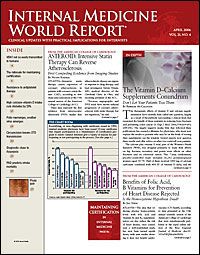%u201CThe Pill%u201D at 45: The Revolution Evolves
“The Pill” at 45: The Revolution Evolves
NEW YORK CITY—First introduced 45 years ago, the oral contraceptive (OC) pill
remains the most widely used method of contraception among American women,
even as the use of other contraceptive hormonal delivery systems grows and sterilization
becomes increasingly popular among baby boomers. “Obviously, sterilization is not going to
be the method of choice for most young women or couples who are uncertain about whether to have children or another child,” said Susan Wysocki, RN, president of the National Association of
Nurse Practitioners in Women’s Health, at a meeting in New York City marking the 45th anniversary of the birth of the birth control pill. “The pill has been refined, is safer now, and, most importantly, is effective at preventing pregnancy. Its durability comes from the fact that
it does the job.” Among the findings presented were data from an industry-sponsored and
ongoing nationwide phone survey called FACTS (Female Attitudes and Contraceptive
Trend Study). According to this survey, on average, a woman uses 3 pregnancy
prevention methods during her lifetime, and 8 of 10 women aged 15 to 50
years have used the pill at some point. “This confirms the intuition that women
use different methods of contraception at different times because of different life
situations,” said Vanessa Cullins, MD, vice president for medical affairs at the Planned
Parenthood Federation of America. “The pill might be ideal when a woman is
younger. It’s easy, reversible, and affordable. But, with age, the IUD [intrauterine
device] or even sterilization might become an attractive option.” Ms Wysocki and Dr Cullins both noted the renewed popularity of the IUD among American women following decades of
disuse after the Dalkon Shield, a defective IUD, was withdrawn from the US market in the 1970s.
“This is a terrific development,” said Ms Wysocki. “While the upfront costs of the
procedure can be high, when the cost is spread out over the 5-plus years that it
remains implanted, it turns out to be the cheapest form of birth control, very highly effective, and something you can forget about for a long time.” Dr Cullins said that while research
indicated that the Dalkon Shield posed health dangers, “other IUDs are safe
and effective, and the method of insertion has been advanced to limit the risk
of infections.” Noting the approval of the norelgestromin/ ethinyl estradiol transdermal patch
(Ortho Evra) in the United States since 2001, Dr Cullins said, “This is just a switch in how the hormones are delivered. It is a great relief for women who need relief from the stress of ondering if they took their pill today but who are not ready for an IUD or sterilization.” Both Dr Cullins and Ms Wysocki emphasized that whatever method of birth control a woman chooses, it should be combined with the use of a condom. “People should use both. A pill, patch, an injectable, or whatever is not going to stop sexually transmitted diseases,” Ms Wysocki said. According to data prepared by the Alan Guttmacher Institute and submitted to the Office of Population Affairs, Department of Health and Human Services in July 2005, 47% of women use OCs. This
is a 15% decrease from the 62% of users in 1995. Until 2004, the decrease in OC use
was largely offset by greater use of injectable hormonal contraceptives. In 2002, injectable medroxyprogesterone acetate (Depo-Provera) was the method of choice of 20% of contraceptive users, compared with 12% in 1995. But use of medroxyprogesterone acetate decreased
to 18% in both 2003 and 2004. Two new hormone delivery methods, the patch and the ring (norelgestromin/ ethinyl estradiol transdermal patch and etonogestrel/ethinyl estradiol vaginal ring
[NuvaRing]), have steadily increased in popularity, from 3% in 2002 to 7% in
2003 to 8% in 2004. A total of 18% of female contraceptive users said that condoms were their primary birth control method, up from 13% in 1995; 3% of users rely on sterilization,
and 0.5% use spermicidal methods. IUD use has remained constant at 2% since 2002. Numerically, IUD users have risen by 105% over 9 years, from 38,000 in 1995 to 78,000 in 2004.
